Repelling squirrels is like making war. We use dogs to chase them, hold prisoners in cages, spray chemicals, deploy robots to spray them with hoses, build walls and barriers to keep them out and open fire when we see their dark little eyes.
During this never-ending war, we trade time relaxing in the garden and enjoying our backyard to find new ways how to keep squirrels away. And we spend lots of money, from the $20 fake owl that fails right out of the box to the $100 bottles of liquid fence that wash away with the next rain shower.
And the moment you think you’ve won, suddenly, one night, there’s a rustling, scratching sound from the attic over your bed.
It’s time to switch from tactics and toys to a strategy for finally repelling squirrels forever.
Ever wonder if that howl you hear is a coyote or a wolf?

Repelling squirrels: War planning.
Most of us try to fight our war against squirrels without understanding the enemy. Lack of knowledge is why the squirrel repellents we buy online afford us scant, often no, relief. And when we finally realize how intelligent these little pests are, we turn to someone who knows them; those expensive pest control experts.
So, your first step is to learn everything you need to know about squirrels (gray and red, for our American readers) to beat them.
Your second step is to devise a defensive and an offensive battle plan. Defending against squirrels will involve employing a line of resistance to keep them out of your home and garden. The offensive plan will include trapping and even killing them.
The nuclear option. As awful as it sounds, you may have to use squirrel poison. Using poison may offend some readers, but a severe squirrel infestation may require using poison. And those with horses know the holes ground squirrels make are just big enough to trip a horse and rider.
You found a coyote puppy. Turn it in or keep a coyote as a pet?
Knowledge, the best squirrel repellent.
Even if you think you know enough about squirrels to skip this section, don’t. Most of this information will be used to create your first and most important offensive plan—hunting squirrels outside your home.
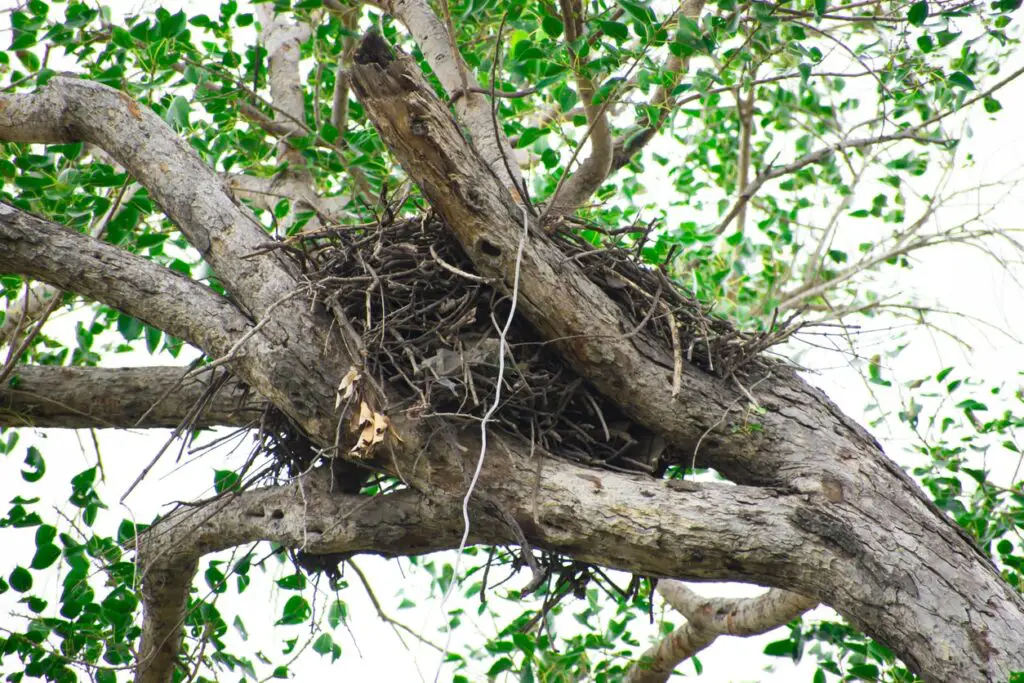
Where do squirrels live in nature?
Squirrels generally live in wooded areas and, aside from ground squirrels, make their homes and winter nests in trees. Trees like the maple, elm, or pine also provide squirrels with tree nuts, flowers, and buds they need to survive.
And the trees benefit from having the squirrels around. The gray squirrel, in particular, helps by scattering and burying tree nuts over a wide area. The unrecovered nuts take root and become new trees.
Once you are in suitable habitat, squirrels are easy to locate. They can be seen and heard leaping from branches, scurrying across dry leaves, or whistling and barking warning alarms to each other.
Red squirrels are active all year, solitary in nature, and quite aggressive and vocal about defending their property. Their five-acre territories will contain at least one centrally located midden—a large pile of tightly packed cones and nuts stored as a future food source.
Gray squirrels will litter the ground with the gnawed and discarded remnants of pine cones and acorns. The gray squirrels’ habit of typically eating in a known safe spot will be evidenced by this garbage collection and is proof of their residence.
The easiest time to find a squirrel’s nest (drey) is in the fall after all the leaves have fallen. Their nest will be conspicuously visible, tucked into the tree branches.
What are those coyotes saying to each other? How to translate coyote howls and bark.
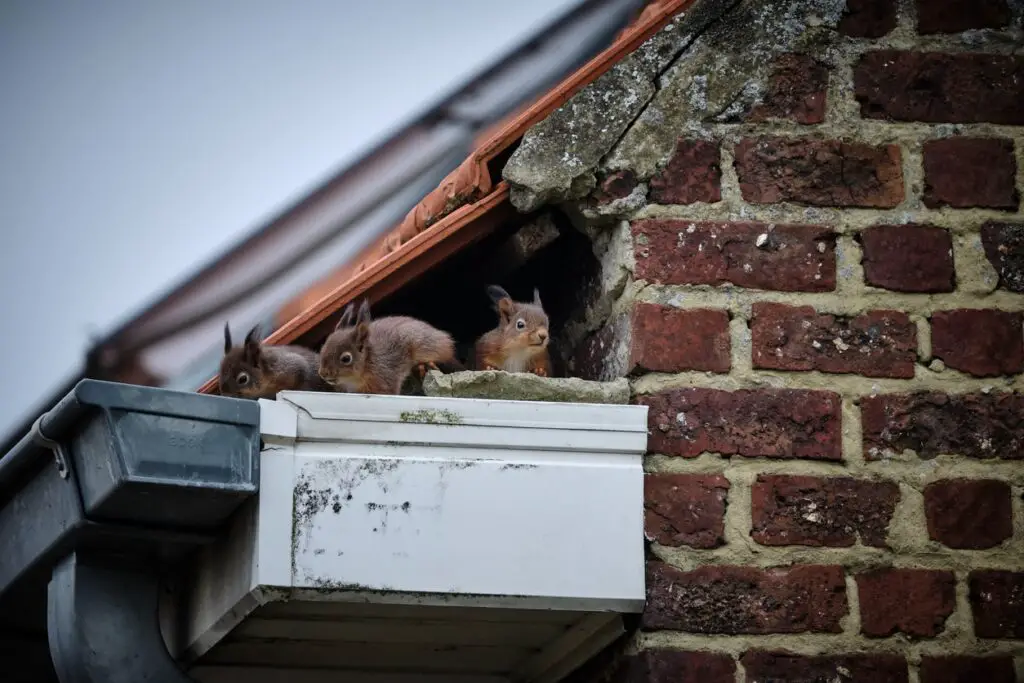
Where do squirrels live in your home?
A squirrel who finds a way into your home will build its nest in your attic or exterior walls. Here is where all the nest building material and warmth are provided free of charge, your home’s insulation, and especially that pink fiberglass stuff.
Other places squirrels like to take up residence, especially during their breeding season and the winter, include your shed, crawl spaces, and garage.
Unlike a tree, a nest in your home offers protection from predators like hawks, foxes, and coyotes. And there’s no better place to birth a handful of kittens (baby squirrels).
How does a squirrel get into your home?
Through the front door, if you are unlucky. It is incredible how much damage a one and half pound rat can cause trying to escape from a house. Add a dog and eight hours before you come back from work, and a tornado would be ashamed of how powerless it is compared to the squirrel.
It sounds silly, but the best squirrel deterrent is a screen door and closed or screened-in windows. Trust me; it’s a thousand times better to have a squirrel in your attack who wants to be there than an angry one in your living room who wants out.
Most of the time, a squirrel will gain entry to your home through the roof. Any hole or damage to your soffit will attract its attention. The hole doesn’t have to be very large, and you might not even notice it. If it isn’t large enough, the squirrel will turn its always growing teeth to the task of
Squirrels are known to enter our homes. They are agile rodents and will get in through the tiniest of holes. They do this by finding entry holes in already damaged areas of your home or construction gaps chewing their way in. Sometimes, squirrels get stuck in attics, crawl spaces and in between walls, they will cause significant damage trying to get to their freedom.
When squirrels get into your home, they will likely do this through the roof. They are normally looking for nesting shelter, and our attics offer the best spot. Squirrels seek out the attics since their young ones get vulnerable to predators when they nest in trees. When squirrels get into the eaves of your building, they will often cause damage by chewing through the holes.
Did a coyote poop in your yard?
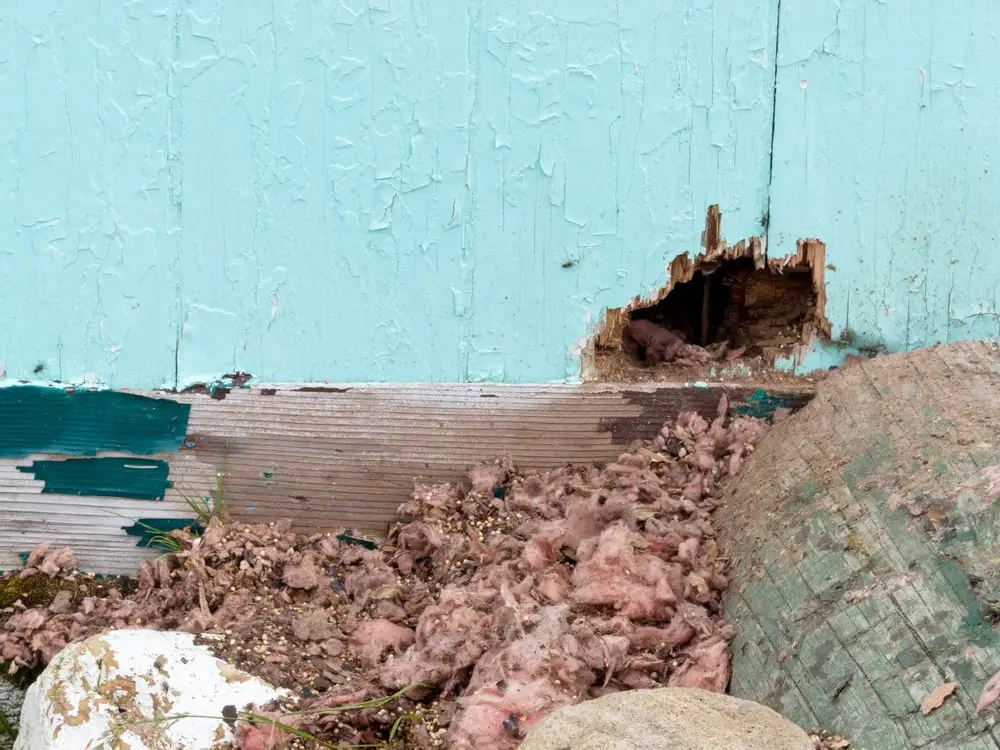
Repelling squirrels: First keep them out of the house.
Repelling squirrels by first focusing on defending your home is your first step. This will take less time than setting traps, baiting, or hunting them down, though all that will come later.
What if you already know you have a squirrel or other rodent or bat infestation? You should seriously consider calling a pest removal expert. But, yes, it will be expensive (around $1500), and your homeowner’s insurance usually doesn’t cover it.
You can reduce the costs by letting the pest remover do the removal and cleanup, but handle all the exclusion tasks (covering entry points) yourself.
Exclusion, the best deterrent for squirrels.
Before repelling squirrels, we need to exclude them from the house. Exclusion is the best deterrent for squirrels because of what it does for your home’s overall value. The cheapest way to maintain the value of your home is to frequently and regularly inspect it and then make minor fixes before they become significant problems.
Squirrels gain access through holes. Unfortunately, these holes also allow water to gain entry into your home. Water does its damage but also brings mold, rot, and rust. You can prevent these by simply taking an annual house tour and inspecting it for holes or weak areas.
Where to look for holes on your home.
Squirrels will enlarge any hole they believe will lead to a safe and comfortable home for the winter and the babies. So, conduct your tour of the spaces below with an eye for any damaged areas.
Chimneys, soffits, damaged windows or doors, any exterior penetration with a damaged seal, gable vents, roof ends, and roof vents.
Where you find holes, damage, or weak points repair what you can and have an expert fix the rest for you.
Why is that fox screaming at night?
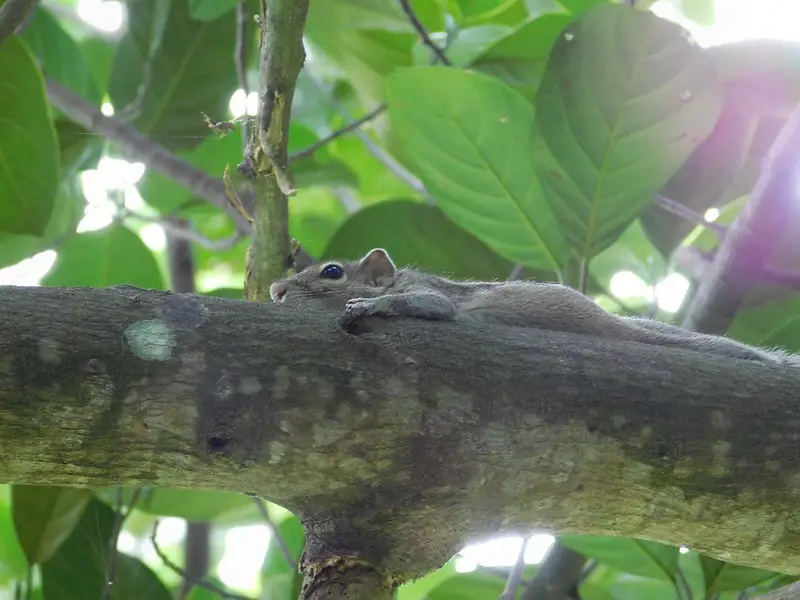
Repelling squirrels before they get to your home.
Looking at the war between you and squirrels, repelling squirrels from your home is like repelling boarders during the Golden Age of the Sail. Don’t let them get close enough to get aboard.
Keeping squirrels off your roof is as simple as trimming tree limbs at least 10’ from your home. That’s 10’ away from or above your roof. It is believed that a squirrel can and will safely jump seven feet horizontally and nine feet vertically.
Don’t forget to keep bushes, trash cans, and other outdoor items the same distance from your home.
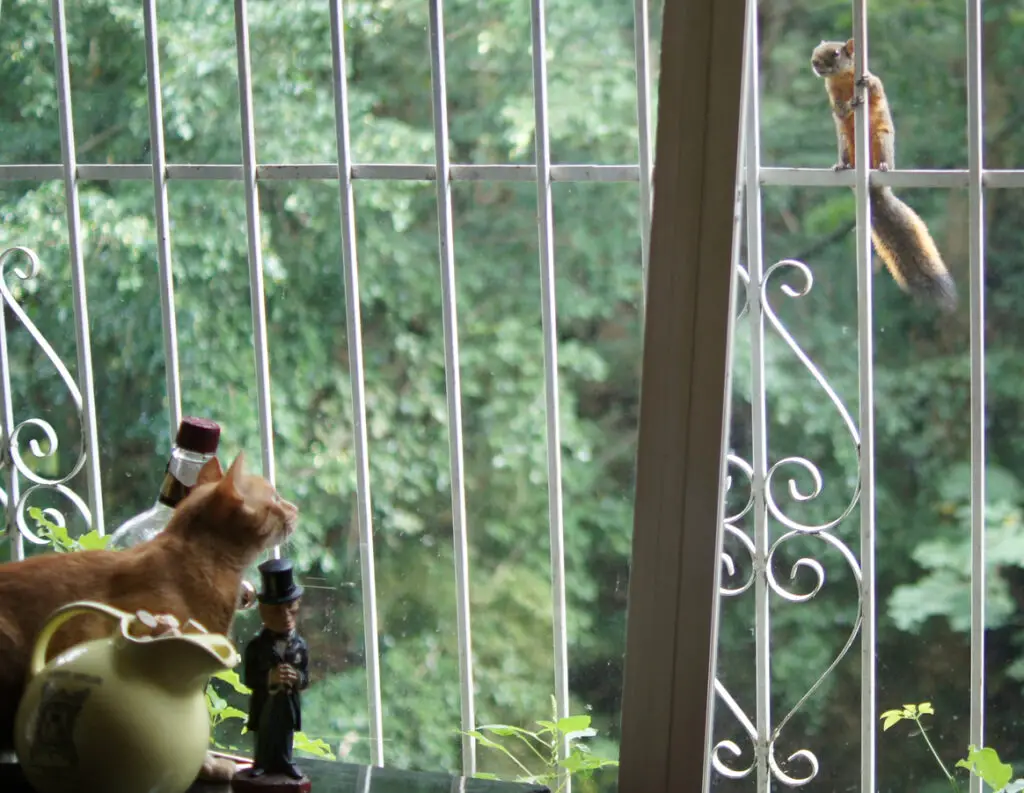
Post a squirrel deterrent pet outside your home.
Dogs chase squirrels but rarely catch and kill them. That’s okay; they are still excellent squirrel repellents. Squirrels seeking an entry point to your home are looking for the fastest, safe test place to build a nest. Encountering a dog will cause a great deal of worry for squirrels and make them try another location.
Cats, on the other hand, hunt and kill squirrels. Your average cat is a natural squirrel predator. They don’t just chase squirrels for fun; they aim to kill them. Fido may bring a dead squirrel to show you how good a boy he is, but your cat may just give you a sullen look while it finishes eating it.
If you don’t have a pet, consider an electronic squirrel sprayer. These simple devices hook up to a garden hose and act as constant guards against any motion within their protected areas.
One caveat: Don’t use these devices if you are on a well. They work pretty well, driving off deer from gardens and squirrel crossing the front yard. But, man, do some dogs love to play with these things. My English Mastiffs would sound all day biting at the streams of water and dancing under the showers of water the sprayer made every time they moved.
How to keep a squirrel out of a garden.
One squirrel can wreck an afternoon of your work spent in the garden in a single day. Unfortunately, repelling squirrels from your flowers, fruits, and vegetables means more work and expense for you.
But squirrels are the biblical garden equivalent of moths and rust. You must put in the work to reap a harvest before they do.

Using scents near you garden as a squirrel repellent.
Using a scent as a repellent for squirrels makes sense, to a degree. Squirrels use their sense of smell to mark their territory, find buried grubs and nuts, and identify each other.
To protect your garden, you’ll use scents to keep squirrels 10 feet away or less when attacking, either as a squirrel repellent or a squirrel lure (for trapping and baiting later).
Coyote urine. Coyote urine is sold and marketed as a coyote lure for coyote hunting and trapping and as a deer, rabbit, and squirrel deterrent. It has a powerful stench, and the manufacturer will send it to you with the bottle cover securely taped in place and the bottle wrapped in tight layers of plastic.
I have never found coyote urine effective at luring coyotes or repelling squirrels, deer, or rabbits. However, it will deter you from being downwind of any place you poured the urine.
Capsaicin, mace, and hot pepper sprays. While these products are great at keeping humans away, the commercial sprays sold as squirrel deterrents in a garden aren’t worth the cost. They require constant reapplication and often appear to have no effect, and you’ll need to read the reviews carefully (many complaints about the sprayer).
White vinegar. As far as being a good squirrel deterrent, it meets our requirement to keep squirrels 10 feet away or less, emphasizing less. But, there’s the problem, applying it in sufficient quantities means constant reapplication of a product that will kill many plants it contacts.
To avoid the problem of overspray, it is best to use this product before plants have sprouted and appeared above the surface of the soil. You should also note that white vinegar is an excellent weed killer.
Peppermint oil. Again, the idea is to offend the squirrel’s sense of smell and use the odor of the peppermint oil as a squirrel repellent. However, when used outside, peppermint oil sprays may smell great, but they quickly wash away and are not as effective at repelling squirrels as mice.
In the end, scents used outdoors are too easily and quickly rendered useless by the elements. And, if you start thinking, maybe they can be used indoors? Exclusion is the best way to keep squirrels out of your house.
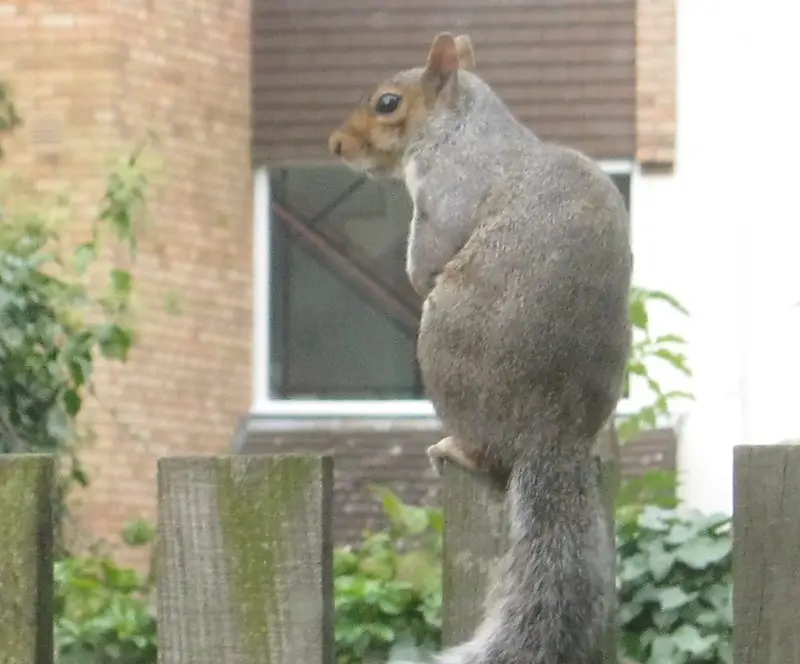
Fencing, the best way of repelling squirrels from a garden.
At the end of the day, the best tactic for repelling squirrels from your garden is fencing.
While building your fence, you should also consider the other animals who may wish to dine on all your hard work. Mice, deer, and rabbits come to mind, but so do some critters that will kill your chickens, like foxes and weasels.
So you might as well build a fence that keeps everything out of your garden, whether they eat from it, poop in it or digs insects out of it.
I’m not going to recommend any specific fencing materials, but you need to ensure any openings are small enough to keep the targeted animal from squeezing through them. I also make sure anything I use is rated for squirrels and coyotes (but that’s just my specific problem animals and me).
Building a fence that keeps squirrels out of a garden.
Begin by burying your fence at least 6 inches into the ground and out and away from both sides of it (up to 1.5 feet if coyotes and foxes are an issue). A good 1/4 hardware cloth buried under your fence will keep the squirrels from tunneling under it.
To top all this fencing off (no pun intended), you should consider some aerial netting. Hey, the squirrels won’t like it either, but it will keep birds off your fruits, vegetables, and plants. However, I do admit netting can be a hassle, so make sure you take the time to set it high enough for you to work under.
A word about plastic: it simply does not work. Plastic fencing is a complete waste of your money and time. Instead, use rodent-proof wire and steel.
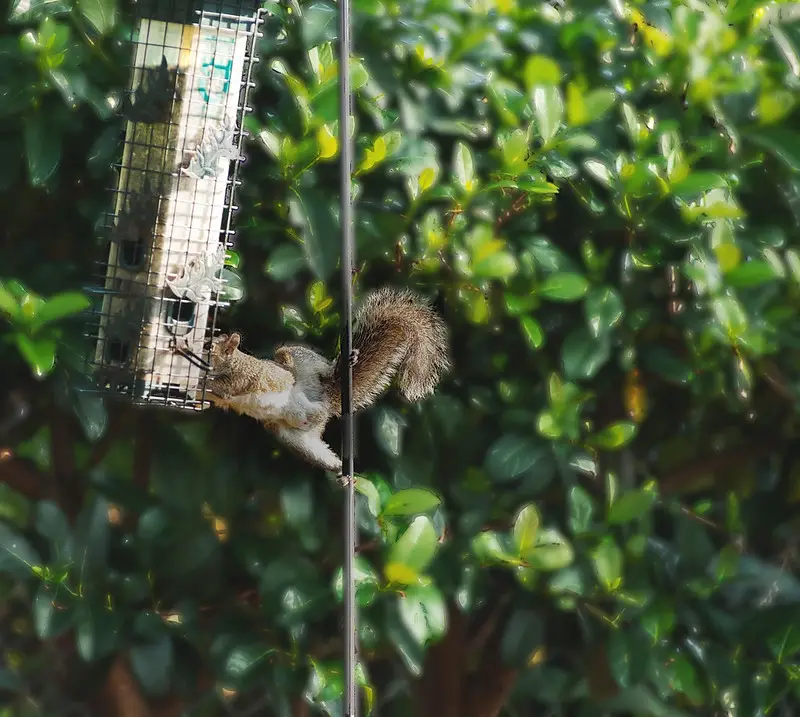
Repelling squirrels from bird feeders
Sadly, no “how to keep squirrels away from bird feeders” tips will work. Bird food is a delicious treat for squirrels, bears, and, wildly enough, some birds.
Squirrels will be able to smell your bird feeders from quite some distance away, and once they do, they will seemingly have no other desire in life than to get at those seeds.
The few options you have are:
- Treat protecting your bird feeders the same way you protect you house. Keep the boarders away from the boat. Use a 10’ clearance zone around and below your feeder to keep squirrels from accessing it.
- Never suspend a bird feeder from any object squirrels have access to. A determine squirrel can climb down something it could never climb up.
- Bird feeders mounted on poles should be treated with a light coat of WD-40 or vegetable oil. This should keep squirrels frok climb in the pole.
- Placing an inverted 12” cone , facing down and at least 7 feet up from the bottom of the pole. The squirrels can’t jump past it and cannot get around it if it’s at least one foot wide.
Modern bird feeders: The best way to keep squirrels out of your bird feed.
Again, I don’t want to recommend any particular product here. Instead, I suggest you look into some of the modern bird feeders specifically designed to keep squirrels from reaching the bird seed r deny them access to it.
Modern bird feeders use a ladder-style perch that, while allowing various birds to land upon them, is weight sensitive. If 1.5-pound squirrel land on the perch, the weight-activated perch will close its feeding ports. Today’s better bird feeders are designed to keep the squirrel from lifting and opening the feed door while standing on the perch.

How to keep squirrels away with lethal measures.
If repelling squirrels isn’t enough, you may have to poison or hunt them down.
Poison is a last resort. Make sure you use and apply in strict accordance with the manufacturer’s instruction. I’ve never had to use it, I hunt them to keep their numbers down.
How to Hunt squirrels in your own backyard.
I recommend you use a pellet gun, not a rim fire rifle. A pellet gun is safer, cheaper, and quieter but just as effective as a .22 rifle. In addition, you can get .22 caliber pellet guns that a neighbor won’t hear when fired far enough away—so no noise complaints.
Check you local laws and regulations before hunting squirrels in your area.
The best squirrel repelling air rifles come in two types; break barrel and Pre-Charged Pneumatics (PCP).
Repelling squirrels: Break barrel air rifles as a deterrent for squirrels.
Break barrel air rifles are widely available in .177 and .22 calibers. Breaking the barrel (basically folding the rifle in on itself) compresses the air with enough force to produce a minimum of 1,000 FPS for a .177 pellet or 800FPS for a .22 pellet to kill a squirrel.
Break barrel air rifles have two minor drawbacks. The first is the action of completely breaking the barrel can require a great deal of force. After breaking the barrel, a pellet is inserted into the rifle, and the barrel is locked back into place. Most smaller adults will have to find a way to work around this issue.
Secondly, there can be minor differences in shot placement between each firing. This is because the barrel (cocking lever) and the breech don’t always come back together in the same exact position. However, the loss of accuracy is negligible at the suggested ranges for hunting squirrels.
Pre-Charged Pneumatics (PCP) air rifles for repelling squirrels.
I confess you do not need to spend the money to buy a PCP squirrel gun. Unless you have a fox killing your chickens or want to hunt gophers, rabbits, or other small game—PCP air rifles are unnecessarily expensive. No, they are worthless for someone who will only be hunting squirrels.
PCP air rifles for squirrel hunting.
A pre-charged pneumatic air rifle is just that, a rifle with an air tank pre-filled with highly compressed air. And boy, do I mean highly compressed! I recommend the Benjamin Armada Air Rifle—that baby takes 3,000 psi (if you buy one, get the pump for it). This rifle fires .22 caliber pellets at 1,110 FPS and can fire 30 pellets on a single air tank charge. It is deadly accurate and will kill a fox (with a headshot—using an included scope) at 25 yards.
PCP air rifles are even more expensive than a Ruger 10/22. But they are much quieter, and there are fewer fliers (errant rounds). Filling the tank is a chore—but less work than breaking a barrel 30 times for the same number of rounds fired.
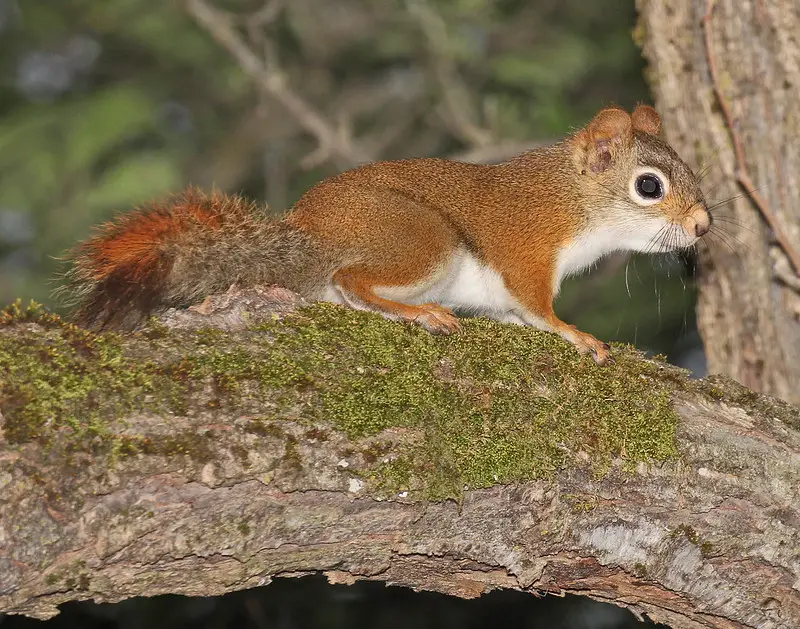
Hunting squirrels around the house and yard.
You can read my whole article her on Tips and tricks for hunting squirrels.
When is the best time to hunt squirrels?
The most significant squirrel activity periods occur in the morning and late afternoon. On warmer days during the summer, squirrel activity is severely limited from 10 a.m. to 2 p.m.
During most squirrel hunting seasons, squirrels begin moving about 1/2 hour before sunrise and cease all movements about 1/2 hour before sunset.
Squirrel activity drops off quickly as temperatures dip and winds increase.
For the record, I own the Gamo Swarm Maxxim G2 .177 Cal Multi-Shot Pellet Rifle and the Rugеr Impact Max Elite .22 in the photo above. Both come with scopes, but I love using iron sites and left the Ruger bare.
Using an air rifle limits the noise you make taking a squirrel, which often leads to a fatal surprise for the next squirrel you encounter. However, using the Gamo or Ruger I use, with their built-in noise dampers, I can hunt squirrels, even while hunting deer.
As to my preferences when using an air rifle; I site both rifles for 20 yards and buy the more expensive pellets. I haven’t done any scientific research on this, but sighting at this range allows me to take larger grey squirrels at up to 30 yards (with 1/2 hold over). Red squirrels are much smaller, but the scoped Gamo has smoked them a few times at that range as well.
Where do you aim? Center mass, and don’t overthink it.
Winning the war and repelling the squirrels.
Now you have battle plan. Now, maybe you can enjoy your yard a little bit more. Good luck!

